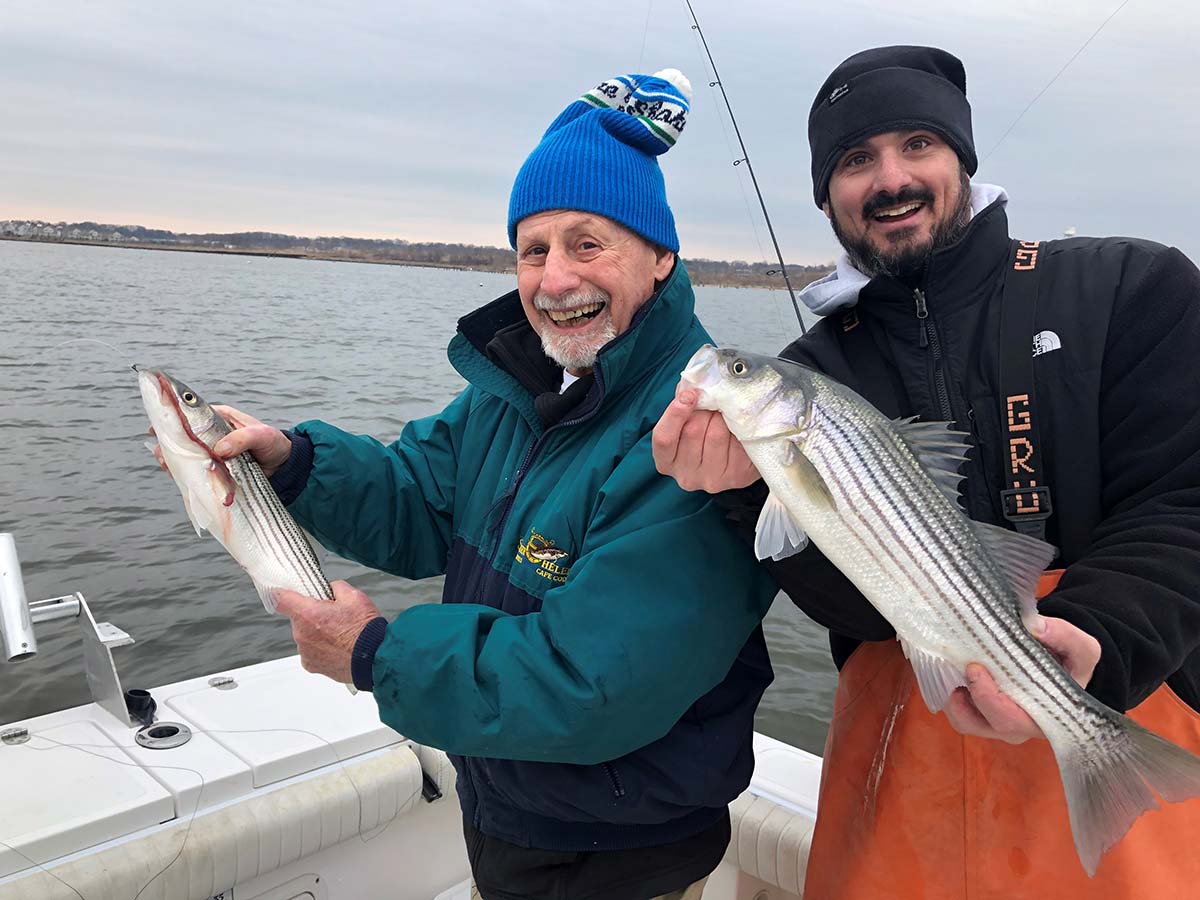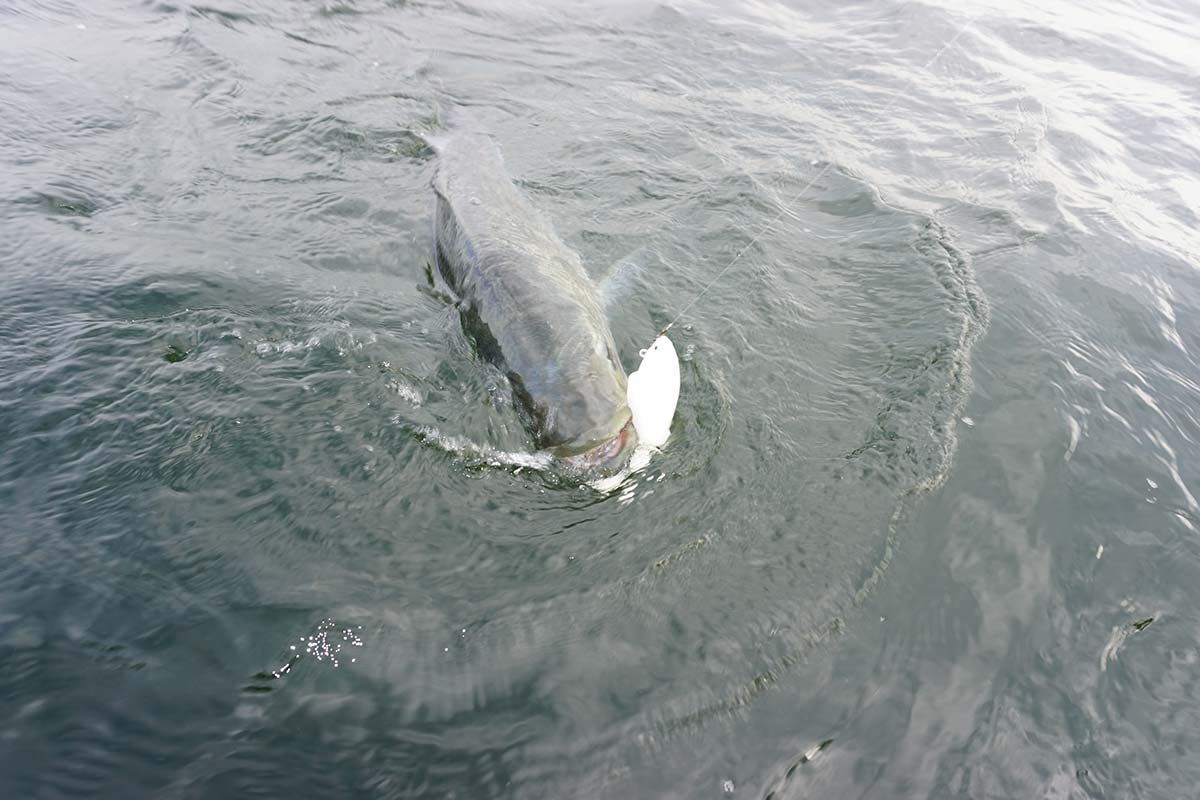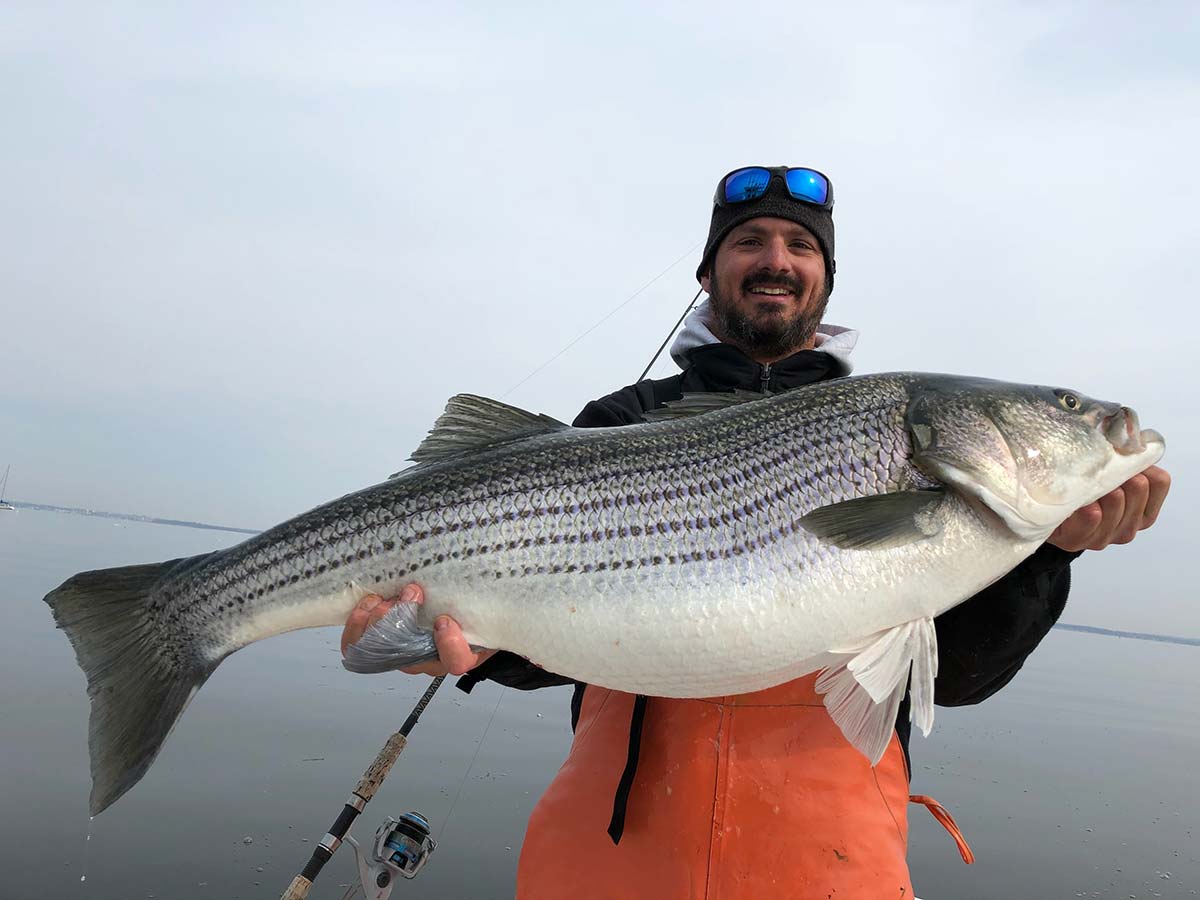
Bankside worming in March leads to an epic catch and release bite on the Raritan come April.
The surest way to look like a fool is to use the words “sure thing” about a fishery. But in the case of Raritan Bay’s early spring fishery I have complete confidence in the outcome.
The Hudson River striped bass spawning stock may be small in comparison to those from the Chesapeake and Delaware, but it appears to be in good shape; and it’s only a few miles from where they open up the NY/NJ Bight striper season in Raritan Bay which is one of the easiest hot spots for even newcomers to fish.
The only problem I can foresee would be the failure of bunker to arrive well before large stripers in the bay. We used to think that May and June were the prime months for large stripers in the bay, but during the last few years it appears that April may be even better. The March arrival of bunker has become a standard despite cold water temperatures, though stripers don’t seem to feed on them until the waters warm a bit in April. At least that was the case until last year when the first reports of big stripers on bunker and lures came in by the third week in March!
Yesterday & Today
The COVID-19 pandemic changed everything last spring, but it worked in favor of long term continued great striper fishing. Despite an abundance of 15- to 30-pounders there was relatively little pressure on the Hudson River spawning stock due to stricter fishing limits and the decrease in effort with social distancing regulations. As a result, many more stripers were able to complete their spawning activities upriver in May and improve the likelihood of another strong year class for the future. The “good old days” of Raritan Bay striper fishing can be enjoyed in 2021.
It wasn’t always like this. When I was growing up on Long Island in the 1950s, the Hudson River was considered a virtual cesspool as poor sanitation and industrial wastes fouled the discolored waters. Striped bass proved to be so hardy as to be able to survive in those waters, though they were barely edible. While I was at Colgate University from 1954-58, one of my Lambda Chi Alpha fraternity brothers, Tremp Saltsman, invited me to spend a weekend in his home at Rhinebeck so we could cast bucktail jigs at the train bridges over creeks entering the Hudson to catch a few school stripers. Tremp said they were edible if filleted and all dark meat removed. However, the one his mother prepared still tasted of the river.
It was many years later before I ate another Hudson striper caught much further downriver by the Governor’s Island area of New York City and still found the poor taste. After that I decided not to eat another from the river unless it was a fall bass with the purple sheen or covered with sea lice proving it was a migrating bass from the ocean.
The big change in the Hudson occurred when Bob Boyle wrote a 1965 article in Sports Illustrated about the disgraceful condition of the river and failure to enforce regulations intended to prevent pollution. Boyle also wrote a book, The Natural and Unnatural History of the Hudson River which helped create the Hudson River Fisherman’s Association, an organization whose members continue to monitor and protect the river with chapters on both sides.
The next big problem was the discovery that Con Edison was killing huge numbers of small stripers at their Indian Point Power Plant and hauling away truckloads to a dump. It was only then that they installed screens to protect all but the smallest bass, though there was still no protection for eggs and larval bass close to the river spawning area. Another shock emerged when it was discovered that GE had discharged PCB particles which were being absorbed by fish and posed a threat to the health of anyone eating those fish. That caused a huge disruption in NY/NJ Bight fisheries as trace PCB findings in many species resulted in health warnings. Yet, that pollution may have worked in favor of the striped bass stock.

Conservation For The Future
There was no conservation in the New York Conservation Department at that time as the Commissioner was Perry Duryea, Sr., owner of a commercial fishery business at Montauk. The only regulation on striped bass was a 16-inch to the fork of the tail minimum in New York and 18 inches overall in New Jersey. At the time, both recreational and commercial fishermen in New York could catch all they wanted year-round, and haul seiners on the east end of Long Island often wrapped up hundreds of thousands to dump on the market for pennies a pound.
The Hudson River stripers were also netted and sent to market before the PCB situation finally forced the state’s health department to prohibit sale of those fish. That was a poor way to achieve protection, but the long range result has been a prospering stock which has provided outstanding Raritan Bay fishing as well as in migratory areas up to New England even as anglers are often unhappy with the southern migratory runs along the coast from Chesapeake and Delaware bays.
Another key contributor to the present striper fishery was the action of Lou Figurelli and the Natural Resources Protection Association he formed in getting netting banned off Staten Island. That not only protected striped bass directly but also kept the New Jersey bunker boats out of a large portion of the bay, thus providing the necessary forage to support the stocks.
Tony Arcabascio, better known as tackle innovator Tony Maja, is a Staten Island native with whom I enjoyed many great mornings releasing big stripers primarily by chunking bunker before the New York season opened each spring in May. Yet, while growing up there Tony had caught only some school stripers while fishing mostly for bluefish. Bunker were a rarity in Great Kills Harbor in those days and anglers had to run across to the Sandy Hook Bay pound nets in order to buy them for bait. The only bunkers he saw in the harbor seemed to be dying, but he scooped them up for crab bait.
The bait situation in Raritan Bay has changed completely in recent years, with both the bay and tributaries loaded with menhaden that can usually be cast-netted or snagged at will, and are rarely ignored by stripers starting in April. While chunking in April aboard Tony’s boat Maja (nothing to do with magic — the first letters of his family’s names) years ago there was rarely any problem catching big bass right outside Great Kills Harbor until the water warmed a bit and bluefish invaded. That wasn’t too much of a problem for Tony since his fish-finder rig ended in a nylon-covered wire leader. That was before fluorocarbon leader material but there was no need for it in generally dingy Raritan Bay. The once pesky bluefish have all but disappeared in the bay during the last couple of years.
March Madness Begins
Shore anglers usually get striper fishing started in the bay by casting sea worms or clam into the shallow waters warmed by the sun, though the bite is normally best on high tides at night. Bloodworms or sandworms of course are the predominant bait of choice throughout the region at the start of the March striper fishery in New Jersey, from the Delaware up along the Great Egg, Mullica and Toms, as well as the bayshore beaches of the Raritan. The first signs of life in the northern waters may appear in late March, but April is prime time for that bite which consists of mostly shorts though bass over 28 inches become more common as waters warm.
A productive boat fishery for schoolies also used to occur in April as anglers anchored in shallow waters and chummed with clams. Some days it would be all small bass, but on others keepers would be common, though not the big spawners. Large release totals weren’t unusual in that light tackle fishery, and I remember a trip with Capt. Lou Grazioso when over 100 bass were released by the crew on a tide. That fishery seems to have fallen by the wayside as the big spawners have been showing up ever earlier.
Those seeking the first big bass would often do so by trolling bunker spoons or deep diving Stretch plugs. The latter are most common now and ideal for use with standard conventional tackle as very little braid or mono must be streamed in order to get into the strike zone in the bay’s shallow waters which is where the early legal bass are usually found.
Dave Lilly of Hazlet, one of the most respected Raritan Bay sharpies got started last spring by trolling small Maja mojos in 12-foot depths and releasing lots of mostly 30- to 36-inch stripers. Lilly doesn’t start fishing by a specific date, but by a sure signal from nature – earthworms on the sidewalks after a spring rain. He described last spring’s bay striper run as the best ever.
Just how good the April fishery can be was illustrated a few years ago when I joined Chuck Many’s crew on his TyMan from Gateway Marina in Highlands for a trip in early April before he was sure the bass were ready to feed on bunkers. He announced that he wasn’t bringing any back-up clams or trolling lures — it would be sink or swim with bunker only. After castnetting enough to fill the live bait well and icing down others for chunking, we headed across the bay and started marking bass. From that point on we used every bunker on the boat while drifting wherever the wind and current took us while releasing bass after bass that were almost all over 28 inches and up to the twenties, after which we cast Tsunami shads for hits on almost every cast. We fell just short of 100 releases only because one of the crew had to get back for work.

New Regs, New Rigs
It’s hard to beat bunker for striper bait, but keep in mind the new regulation requiring non-offset circle hooks when using natural baits for bass in order to improve survival of released fish. I’ve long preferred circle hooks in any case as I’ve found them to be more efficient if as much hook as possible is exposed and hooking involves only coming tight on the fish rather than striking.
I prefer to cast or jig with lures whenever possible, which is frequently all that’s required in Raritan Bay during the spring. If you’re marking fish, blind casting with large shads works surprisingly well. Just let the lure settle after the cast before starting a steady retrieve so you can feel the tail working. Surface plugs are the most fun, and it’s not unusual to see stripers rolling on the surface or blasting into bunkers. When I was chartering in the bay I kept a spinning rod with a large popper rigged and ready for any sign of surface activity.
Raritan Bay spring stripers are a relatively easy target for anglers from other areas. Before retiring to Bayville, NJ on the Barnegat Bay, Tony Arcabascio had a book of numbers of snags which usually held at least a few bass. By working those spots he rarely failed to score with chunks. However, when the bass turned on the fishing got so good that anyone with a fishfinder could mark fish and drop an anchor to chunk them. Tony referred to those periods as “The stupid fishing.” During recent early springs it’s often not even necessary to drop the anchor as live baits or chunks on the drift may work as well.
A newcomer can get started by simply running to the fleets as they’ll be where the bass were yesterday. Then cruise around while watching the fishfinder for marks and noting the activity of other boats. It’s a big bay, and fishing is often dead at one end while the other may be red hot. If fish are being fought try to duplicate what’s working. A difference of a few feet of depth or the color of a trolling lure may be the key to success. The tidal factor is also very important as a dead area can come alive with a change of tide. That’s especially important in early spring as sunny days and tide changes may result in considerable variations in water temperatures.
Keep in mind the fact that you may be fishing in two states with different regulations. You must be in compliance with the regulations at the point of inspection (one at 28 to 35 inches in New York starting April 15 / one at 28 to less than 38 inches in New Jersey as of March 1). Your word that you caught the fish on the other side of the line is of no consequence. Most fishfinders show the state lines, and since both states require free registrations, it’s best to go to the respective websites for both.
New York – www.dec.ny.gov/permits
New Jersey – SaltwaterRegistry.nj.gov
One of the best aspects of fishing Raritan Bay is that it’s usually fishable for small boaters. I’ve had good fishing while sailing out of Highlands into hard northwest winds and whitecaps that I could barely plow through at slow speed before getting close to Staten Island and fishing in a very pleasant lee. With a southwest wind I could run down the north side of the bay for a lee. Boaters fishing out of Keyport often find very good fishing not far from the ramp. Lots of kayakers take advantage of that area as well. The bad wind for the bay is from the northeast as it blows directly into the bay.
Remember that almost all stripers over 20 pounds are females ready to spawn in Hudson River within weeks; do your best to release these big fish as safely and as quickly as possible. Rest assured, the “Good Old Days” of striper fishing should be occurring again in Raritan Bay this spring; let’s fish responsibly and keep it that way!





